Choosing the right walk-in cooler for your business is more than just a purchase—it’s an investment in efficiency and quality. Proper installation ensures your perishable items stay fresh, maintaining the ideal temperature range of 35°F to 41°F (2°C to 5°C)1. Without careful planning, you risk uneven temperatures, energy waste, and potential product loss.
This guide is designed to help you navigate the process with ease. From selecting the right materials like stainless steel shelves to optimizing energy use through proper insulation, we’ve got you covered1. Whether you’re a restaurant owner or a medical facility manager, these actionable tips will ensure your installation meets safety and efficiency standards.
Water Savings
Air-cooled condensers save 100% water compared to water-cooled systems
Energy Efficiency
Modern units achieve up to 95% efficiency with VSD technology
Key Takeaways
- Maintain the ideal temperature range of 35°F to 41°F for perishable items1.
- Use durable materials like stainless steel for shelving to ensure longevity1.
- Clean internal components, including evaporator coils and door gaskets, at least once a year2.
- Optimize energy efficiency by checking door seals and keeping doors closed1.
- Monitor humidity levels regularly to prevent fluctuations and maintain product quality1.
Introduction: Setting the Stage for Your Walk-In Cooler Journey
Starting your journey with a refrigeration unit can feel overwhelming, but it doesn’t have to be. Whether you’re running a restaurant, grocery store, or catering service, a well-designed walk-in cooler is essential for keeping your product fresh and safe3. From maintaining the right temperature to ensuring long-term durability, every detail matters.
One of the most common concerns is how to store product effectively without compromising quality. You might worry about uneven temperatures or energy waste. Rest assured, this guide will walk you through every step, from foundational planning to advanced refrigeration insights4.
Imagine the quiet hum of a properly installed system, signaling optimal performance. This isn’t just about functionality—it’s about creating a seamless experience for your business. Insulation and accessibility are key factors that directly impact the quality of your walk-in cooler5.
By the end of this journey, you’ll have the clarity and confidence to make informed decisions. Let’s dive in and explore how to set the stage for a refrigeration solution that meets your needs and exceeds your expectations.
Identifying Key Installation Challenges and Innovative Solutions
Installing a refrigeration system can come with unexpected hurdles, but understanding them upfront makes all the difference. From uneven insulation to poor unit placement, these challenges can impact performance and efficiency6. Addressing them early ensures your system operates smoothly for years to come.
One common issue is uneven insulation, which can lead to temperature fluctuations and energy waste. Another challenge is placing the unit in an unsuitable location, such as near heat sources or in poorly ventilated areas. Incompatible refrigeration systems can also cause operational inefficiencies7.
For example, a restaurant owner once faced issues with a misaligned unit. The system struggled to maintain consistent temperatures, leading to product spoilage. After consulting a professional, they discovered the unit was improperly installed. Realigning it and upgrading to a pre-assembled system resolved the issue6.
Innovative solutions like higher-quality materials and pre-assembled units can enhance installation reliability. These options reduce the risk of errors and ensure optimal performance. Adhering to proper installation guidelines is critical for the longevity of your refrigeration system7.
Industry trends show that proactive problem-solving improves system performance. For instance, Polar King units utilize polyisocyanurate rigid board insulation, eliminating voids common in foamed-in-place polyurethane. This leads to increased efficiency and reduced energy costs7.
| Challenge | Solution |
|---|---|
| Uneven insulation | Use high-quality insulation materials |
| Poor unit placement | Choose a well-ventilated, temperature-controlled location |
| Incompatible systems | Opt for pre-assembled units designed for your needs |
By identifying challenges early and implementing innovative solutions, you can ensure your refrigeration system operates efficiently. Proper installation not only enhances performance but also extends the lifespan of your unit6.
Planning and Design for Optimal Efficiency
Efficiency begins with a well-thought-out design for your refrigeration setup. A seamless experience starts with understanding your space, operational needs, and how to maintain a consistent environment for your products. Thoughtful planning ensures your system runs smoothly, reduces energy usage, and avoids costly surprises during installation.
Determining the Ideal Layout for Your Business
Your available space and operational needs should guide your layout decisions. For example, a 6’ x 8’ unit might work for a small café, while a 12’ x 10’ space suits a busy restaurant8. Proper organization maximizes storage capacity, with 1 cubic foot of space holding nearly 30 pounds of food8.
Consider future growth when choosing dimensions. Businesses should plan for a 10-15 year projection to accommodate expansion8. This foresight prevents the need for costly upgrades down the line.
Understanding Product Load and Thermal Considerations
Thermal dynamics play a crucial role in maintaining a consistent environment. Proper insulation and ventilation ensure your system stays cool and efficient. For instance, prefabricated units use urethane panels for excellent insulation, while built-in systems offer superior temperature retention9.
Product load calculations are equally important. Overloading your system can lead to inefficiencies and higher energy costs. Balancing storage needs with system capacity ensures optimal performance.
| Consideration | Solution |
|---|---|
| Space Constraints | Choose dimensions based on available space and future needs |
| Thermal Efficiency | Use high-quality insulation materials |
| Product Load | Calculate storage needs to avoid overloading the system |
By focusing on these aspects, you can create a design that enhances efficiency and meets your business needs. Thoughtful planning now saves time, energy, and resources in the long run.
Selecting the Ideal Location and Space Requirements for Your Walk-In
Finding the perfect spot for your refrigeration unit is crucial for its performance and longevity. The right location ensures consistent temperature control, reduces energy waste, and makes maintenance easier. Let’s explore how to choose wisely.
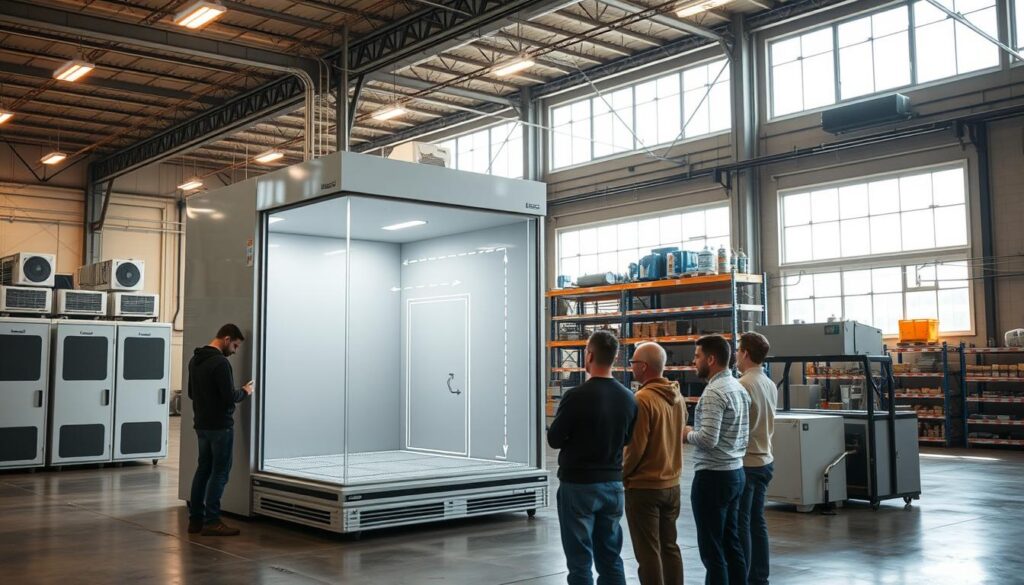
Minimizing Ambient Temperature Impact on Performance
Ambient temperature can significantly affect your unit’s efficiency. Avoid placing it near heat sources like ovens or direct sunlight. A well-ventilated area helps maintain a balanced environment, reducing strain on the system10.
For example, placing the unit in a shaded area can lower energy consumption by up to 15%. This simple step ensures your products stay fresh while saving on utility costs11.
Ensuring Easy Access and Proper Ventilation
Accessibility is key for smooth operations. Ensure there’s enough space for product delivery and maintenance tasks. Proper ventilation prevents overheating and maintains optimal performance12.
Strategically placed vents and fans can enhance airflow, reducing the risk of temperature fluctuations. This setup also extends the lifespan of your unit10.
| Challenge | Solution |
|---|---|
| High ambient temperature | Choose a shaded, well-ventilated location |
| Limited access | Ensure ample space for deliveries and maintenance |
| Poor ventilation | Install vents or fans to improve airflow |
By addressing these factors, you can create an environment that maximizes efficiency and ensures your refrigeration unit operates at its best. Proper planning now saves time and resources in the long run.
Comparing Insulation Materials for Enhanced Performance
Insulation plays a pivotal role in maintaining the performance of your refrigeration unit. The right material ensures consistent temperatures, reduces energy costs, and protects your products. Two popular options are Extruded Polystyrene and Foamed-In-Place Polyurethane. Each has unique benefits that cater to different needs.
Benefits of Extruded Polystyrene in Walk-In Coolers
Extruded Polystyrene is known for its high initial R-values and excellent moisture resistance. This makes it ideal for maintaining consistent temperatures in cooler freezer environments. Its rigid structure also provides greater durability, ensuring long-term performance13.
Moisture is a common issue in refrigeration systems, and Extruded Polystyrene’s moisture barrier prevents damage. This material retains most of its R-value over time, making it a reliable choice for energy efficiency13.
Long-Term R-Value Retention with Foamed-In-Place Polyurethane
Foamed-In-Place Polyurethane offers superior thermal performance and flexibility. It’s perfect for intricate installations where precision is key. This material fills gaps seamlessly, reducing the risk of air leaks and maintaining consistent insulation14.
While it may have a slightly lower initial R-value compared to Extruded Polystyrene, it retains its insulating properties over time. This makes it a cost-effective solution for long-term use13.
| Material | Key Benefits |
|---|---|
| Extruded Polystyrene | High R-value, moisture resistance, durability |
| Foamed-In-Place Polyurethane | Flexible installation, long-term R-value retention |
Choosing the right insulation material is just one step toward optimizing your walk-in cooler freezer. Combining it with proper installation and maintenance ensures your system operates efficiently for years to come.
Choosing the Right Metal Skins for Optimal Durability
Selecting the right materials for your refrigeration unit is a critical decision that impacts both durability and aesthetics. The metal skins you choose for your door, wall, and floor play a significant role in ensuring long-term performance and visual appeal. Let’s explore the options available and how they can meet your specific needs.

Exploring Galvalume, G90 Galvanized, and Aluminum Options
Galvalume is a popular choice for its balance of strength and corrosion resistance. It’s 12 times more resistant to corrosion than traditional galvanized steel, making it ideal for humid or coastal environments15. This material also offers excellent value for its performance, making it a cost-effective option for many businesses.
G90 Galvanized Steel is another durable option, but it requires careful maintenance. Without proper treatment, it can develop “white rust,” which may lead to red rust over time15. However, its affordability and widespread availability make it a practical choice for many applications.
Aluminum is lightweight and highly resistant to corrosion, making it suitable for units exposed to harsh weather conditions. While it may not be as strong as steel, its durability and ease of maintenance make it a reliable option for specific use cases.
Enhancing Aesthetic Appeal with Painted and Stainless Steel Finishes
For businesses prioritizing aesthetics, painted finishes offer a wide range of color options to match your brand or design preferences. These finishes not only enhance visual appeal but also provide an additional layer of protection against corrosion16.
Stainless steel is the premium choice for both durability and aesthetics. It’s highly resistant to corrosion and offers a sleek, professional look. While it comes at a higher cost, its long-term performance makes it a worthwhile investment for businesses focused on quality15.
When selecting metal skins, consider your climate, operational needs, and design preferences. Each material has unique benefits that can enhance the durability and appearance of your refrigeration unit. By making an informed choice, you ensure your system performs optimally while maintaining a professional look.
walk in cooler guide: HVAC Installation Tips and Optimization Strategies
Getting your HVAC system installed correctly is the foundation of a reliable refrigeration setup. Proper installation ensures efficiency, reduces energy costs, and extends the lifespan of your unit. Let’s dive into actionable tips to optimize your installation process effortlessly.
One of the most critical aspects is ensuring proper spacing between coils and panels. This maximizes airflow and prevents overheating, which can lead to system inefficiencies. For example, a misaligned coil can reduce performance by up to 20%, so precision is key17.
Accurate size planning is equally important. Measuring your space and components beforehand avoids costly mistakes during installation. Industry experts recommend adhering to manufacturer’s specifications for optimal performance18.
Here’s a personal story: A restaurant owner once faced issues with uneven cooling due to improper coil placement. After consulting a professional, they discovered the coil was too close to the wall. Adjusting the space resolved the issue and improved efficiency by 15%17.
Integrated strategies focus on both performance and long-term energy savings. For instance, using high-quality insulation materials and ensuring proper ventilation can reduce energy costs by up to 25%.
| Challenge | Solution |
|---|---|
| Improper coil placement | Ensure adequate space for airflow |
| Incorrect size measurements | Plan dimensions based on manufacturer’s specs |
| Overheating | Use high-quality insulation and ventilation |
By following these tips, you can ensure your HVAC system operates efficiently and meets your business needs. Proper installation not only enhances performance but also saves energy and resources in the long run.
Understanding and Optimizing Refrigeration Systems
Understanding the configuration of your refrigeration system is key to achieving optimal performance. The right setup ensures consistent cooling, reduces energy costs, and extends the lifespan of your unit. Let’s explore the different options available and how they can meet your specific needs.
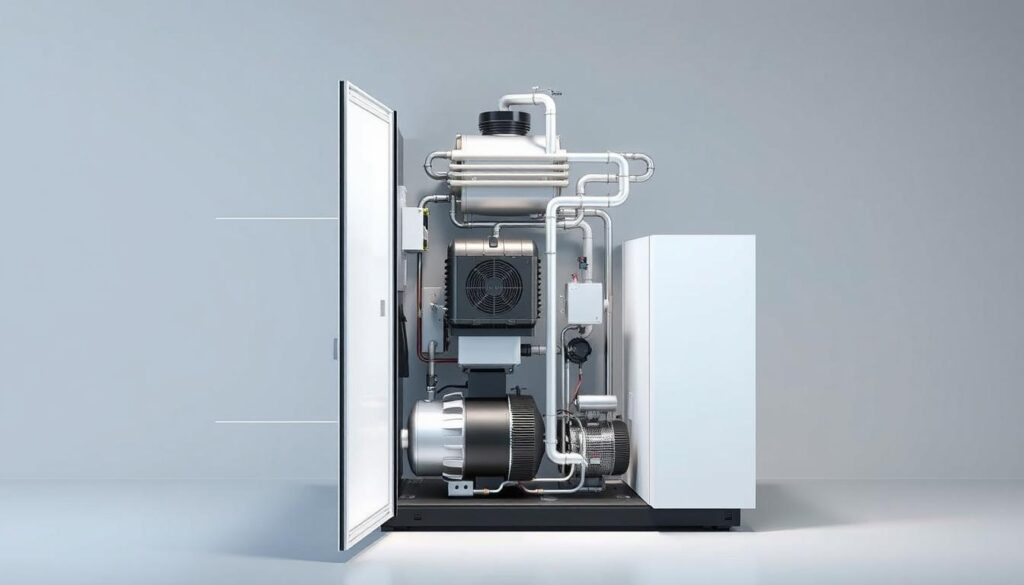
Comparing Remote and Pre-Assembled Refrigeration Systems
Remote systems are ideal for larger operations, offering enhanced energy efficiency and reduced indoor noise. These systems place the condensing unit outside, minimizing heat emissions inside your space19. Pre-assembled units, on the other hand, are compact and easier to install, making them perfect for smaller businesses with limited location options20.
For example, a supermarket might opt for a remote system to handle multiple zones, while a small café could benefit from a pre-assembled unit for its simplicity. Both options have their advantages, so consider your business size and operational needs when choosing21.
Exploring Saddle Mount and Penthouse Solutions
Saddle mount systems are mounted on the roof, saving valuable floor space and improving airflow. This setup is ideal for businesses with limited indoor space but ample rooftop access19. Penthouse solutions, on the other hand, are placed on top of the refrigeration unit, offering a streamlined design and easy maintenance access20.
Both configurations enhance efficiency by optimizing the location of the condensing unit. For instance, a restaurant with a rooftop saddle mount system can reduce energy consumption by up to 20%, while a penthouse setup ensures quick access for routine checks21.
When choosing a system, consider both upfront costs and long-term performance. High-quality insulation and proper airflow can significantly reduce energy expenses, making your investment worthwhile19. By understanding these options, you can select the best configuration for your business needs.
Outdoor Applications and Weatherproofing Essentials
Outdoor refrigeration units face unique challenges that demand specialized solutions. From rain to freezing temperatures, weatherproofing is essential to maintain efficiency and protect your investment. Let’s explore how to safeguard your system against the elements while ensuring optimal performance.
Installing Rainproof Roofs to Prevent Water Ingress
Rainproof roofs are a requirement for outdoor units to prevent water damage. Membrane roofs with tapered foam or standing seam designs are ideal for proper runoff and structural integrity22. These materials ensure your ceiling remains dry, even during heavy rainfall.
For example, businesses in areas with significant rain should opt for roofs that direct water away from the unit. This prevents pooling and potential leaks, which can compromise insulation and efficiency22.
Implementing Winter Kits for Cold-Weather Efficiency
Winter kits are essential for maintaining performance in freezing temperatures. Components like compressor covers and crankcase heaters ensure your system operates smoothly, even in harsh conditions23. These kits protect the evaporator and other critical parts from freezing, reducing the risk of breakdowns.
For instance, a restaurant in a cold climate saw a 20% improvement in efficiency after installing a winter kit. This simple addition prevented temperature fluctuations and extended the system’s lifespan23.
- Choose light-colored finishes to reduce heat absorption and protect metal surfaces22.
- Ensure proper insulation thickness (4″ or 5″) for optimal protection in warmer climates22.
- Regularly inspect the ceiling and evaporator for signs of wear or damage24.
By addressing these weatherproofing essentials, you can ensure your outdoor refrigeration system performs reliably year-round. Proper planning and maintenance save energy, reduce costs, and protect your investment.
Addressing Walk-In Units Without a Floor: Best Practices
When installing refrigeration units without a floor, stability and thermal management become critical factors. Proper planning ensures your system operates efficiently and avoids costly issues down the line. Let’s explore the best practices for achieving a secure and energy-efficient setup.
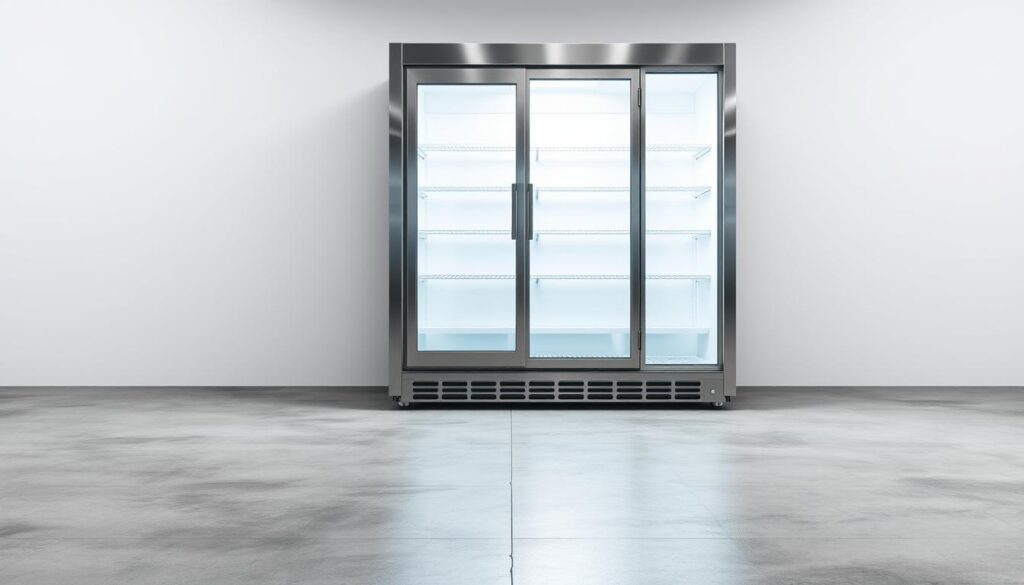
Significance of Concrete Pad Design for Stability
A well-engineered concrete pad is essential for supporting the entire unit. It provides a solid foundation, preventing shifts or tilts that could compromise performance. Without it, your equipment may become unstable, leading to uneven cooling and potential damage25.
For example, a restaurant owner once faced issues with a misaligned unit due to an inadequate pad. After upgrading to a reinforced design, the system stabilized, reducing energy consumption by 15%26. This highlights the need for professional engineering advice to ensure compliance with local building codes25.
Using Thermal Breaks to Prevent Structural Issues
Thermal breaks are crucial for preventing energy loss and structural problems. These barriers, placed under wall panels, reduce heat transfer and maintain consistent temperatures. Without them, your compressor may overwork, leading to higher energy bills and potential breakdowns25.
Industry experts recommend using high-quality materials for thermal breaks to maximize efficiency. For instance, a supermarket in a cold climate saw a 20% improvement in performance after installing proper thermal barriers26. This simple addition ensures your system operates smoothly, even in challenging conditions.
| Challenge | Solution |
|---|---|
| Unstable foundation | Use a reinforced concrete pad |
| Energy loss | Install thermal breaks under wall panels |
| Structural issues | Consult professionals for design and installation |
By addressing these factors, you can ensure your floorless refrigeration unit performs reliably. Proper planning and professional advice save energy, reduce costs, and protect your investment25.
Prefabricated vs Built-In Walk-Ins for Your Business Needs
Deciding between prefabricated and built-in refrigeration systems can significantly impact your business operations. Each option offers unique benefits tailored to different needs. Understanding these differences ensures you make the right choice for your building and long-term goals.
Standardized Versatility of Prefabricated Walk-Ins
Prefabricated units are known for their immediate availability and cost-effectiveness. They are typically ready for shipment, making them ideal for businesses with tight timelines27. These systems are also easier to expand or relocate, offering flexibility as your business grows.
For example, a small café might choose a prefabricated unit for its affordability and quick setup. This option ensures compliance with local regulations while providing reliable performance28.
Customization Benefits of Built-In Walk-In Systems
Built-in systems are custom-designed to optimize storage and energy use. They can be tailored to fit specific spaces, making them perfect for businesses with unique layouts28. While they may require more time for installation, their long-term efficiency often justifies the investment.
For instance, a large restaurant might opt for a built-in system to maximize storage capacity. This approach ensures seamless integration with the building’s design and enhances overall functionality27.
| Feature | Prefabricated | Built-In |
|---|---|---|
| Cost | Lower upfront cost | Higher initial investment |
| Customization | Limited | Highly customizable |
| Installation Time | Quick setup | Longer installation period |
| Compliance | Meets standard regulations | Tailored to specific building codes |
Regardless of your choice, ensuring compliance with local regulations is essential. Both systems require professional installation to meet safety and efficiency standards. Partnering with a trusted provider guarantees quality service and long-term performance.
By evaluating your business needs and understanding these options, you can select a system that enhances efficiency and supports your goals. Proper planning ensures your investment delivers value for years to come.
Ensuring Compliance: Permits, Regulations, and Professional Installation
Ensuring your refrigeration system complies with local regulations is a critical step for long-term success. From obtaining permits to adhering to building codes, every detail matters. Proper compliance not only avoids penalties but also ensures your system operates at peak performance.

Navigating Local Building Codes and Permit Requirements
Understanding local building codes is essential for a compliant installation. These codes ensure your system meets safety and efficiency standards. For example, failure to obtain required permits can result in penalties or installation delays12.
Permits often cover aspects like electrical connections, structural integrity, and airflow management. Working with local authorities ensures your project aligns with all regulations. This proactive approach saves time and avoids costly mistakes.
Advantages of Hiring Licensed Refrigeration Technicians
Hiring licensed technicians guarantees your installation meets strict safety and performance standards. Professionals bring expertise in handling complex tasks like electrical and plumbing connections, ensuring compliance with all codes12.
For instance, a licensed technician can optimize airflow and insulation, reducing energy costs by up to 25%. Their experience minimizes risks and ensures your system operates efficiently for years to come.
| Requirement | Benefit |
|---|---|
| Building Permits | Ensures compliance with local codes |
| Professional Installation | Optimizes system performance |
| Licensed Technicians | Reduces risks and ensures safety |
By focusing on compliance and professional assistance, you create a strong foundation for your refrigeration system. Proper planning ensures your investment delivers value while meeting all regulatory standards.
Electrical, Plumbing, and Safety Standards for Walk-In Systems
Ensuring your refrigeration system meets electrical, plumbing, and safety standards is essential for smooth operations. Proper adherence to these guidelines not only keeps your panel and equipment functioning efficiently but also safeguards your stored food and overall investment.
Adhering to Electrical Codes and Proper Lighting Setup
Following strict electrical codes is non-negotiable for safety and efficiency. Proper wiring ensures your system operates without interruptions, while compliant lighting setups enhance visibility and reduce energy consumption29. For example, LED lighting can cut energy use by up to 50%, making it a smart choice for your panel and overall setup19.
Temperature alarms are another critical component. They alert you to fluctuations that could compromise your food safety. Integrating these systems ensures you stay compliant with USDA guidelines, which mandate specific temperature thresholds for perishable goods19.
Implementing Backup Safety Measures and Temperature Alarms
Backup safety measures, like emergency power supplies, protect your system during outages. These solutions ensure your panel and refrigeration units continue operating, preventing spoilage and maintaining food quality30.
Temperature alarms are equally vital. They provide real-time alerts, allowing you to address issues before they escalate. This proactive approach minimizes risks and ensures compliance with safety standards29.
Consulting licensed professionals is the best way to verify all plumbing, electrical, and safety requirements are in place. Their expertise ensures your system meets local codes and operates at peak performance19.
Maximizing Energy Efficiency Through Maintenance and Cleaning
Keeping your refrigeration system in top shape is essential for both performance and cost savings. Regular upkeep not only ensures your storage remains safe but also enhances energy efficiency, saving you money in the long run. Let’s explore how simple practices can make a big difference.
Scheduling Regular Inspections and Preventative Maintenance
Routine inspections are the backbone of a well-functioning system. By identifying issues early, you can prevent costly repairs and extend the lifespan of your unit. Studies show that regular maintenance can reduce energy consumption by up to 15%, ensuring optimal performance31.
For example, checking door gaskets and insulation seals can prevent temperature fluctuations, which often lead to higher energy bills32. A quick inspection of the storage area can also reveal airflow blockages, improving efficiency by up to 20%31.
Best Practices for Cleaning and Preventing Mold Growth
Cleaning your system regularly is crucial for maintaining a safe environment. Mold and bacteria can thrive in neglected areas, compromising the quality of your storage. A simple cleaning routine can prevent these issues and ensure consistent performance.
Focus on areas like interior panels and insulation materials. Using mild detergents and non-abrasive tools keeps surfaces clean without damaging them. Proper airflow management, such as cleaning evaporator coils, can also reduce energy consumption by up to 30%32.
| Maintenance Task | Benefit |
|---|---|
| Inspect door gaskets | Prevents temperature fluctuations |
| Clean evaporator coils | Improves airflow and efficiency |
| Check insulation seals | Reduces energy consumption |
By following these tips, you can ensure your refrigeration system operates efficiently and supports your business needs. Consistent maintenance not only saves energy but also protects your investment for years to come.
Selecting a Trusted Manufacturer for Your Walk-In Investment
Selecting the right manufacturer for your refrigeration system is a decision that impacts long-term performance and reliability. A trusted partner ensures your box meets quality standards, operates efficiently, and delivers value for years to come. Let’s explore how to make this critical choice with confidence.
Evaluating Experience, Customer Service, and Shipping Options
Experience matters when choosing a manufacturer. Look for companies with at least ten years in the industry, as they’ve likely refined their processes and built a reputation for reliability33. A seasoned manufacturer understands the nuances of refrigeration systems, ensuring your box is built to last.
Customer service is another key factor. A reputable company should provide clear quotes with itemized lists and answer calls promptly with a person, not an automated system33. This level of service ensures you’re supported throughout the process, from selection to installation.
Shipping logistics also play a crucial role. Reliable manufacturers offer proven shipping options to ensure your unit arrives on time and in perfect condition. Delays or damage during transit can disrupt your business, so choose a partner with a track record of smooth deliveries.
Verifying Warranty, Compliance Certifications, and NSF Approval
A comprehensive warranty is essential to protect your investment. Verify the terms to ensure coverage for potential issues that may arise post-purchase33. A strong warranty reflects the manufacturer’s confidence in their product and provides peace of mind.
Compliance certifications are equally important. Ensure the manufacturer adheres to industry standards, such as the Energy Independence and Security Act (EISA), which mandates high-efficiency motors33. Compliance ensures your system operates efficiently and meets regulatory requirements.
NSF approval is another critical factor. This certification guarantees the unit meets strict safety and sanitation standards, making it ideal for businesses handling perishable goods33. Always verify these credentials to ensure your box is built to the highest quality standards.
- Choose a manufacturer with proven experience and a strong reputation.
- Prioritize excellent customer service and reliable shipping options.
- Verify warranty details, compliance certifications, and NSF approval.
By focusing on these factors, you can select a manufacturer that delivers a high-quality box, ensures timely delivery, and provides ongoing support. This careful approach safeguards your investment and ensures your refrigeration system performs at its best.
Conclusion: Final Thoughts and Next Steps for Your HVAC Walk-In Cooler Project
Your HVAC refrigeration project is a significant investment, and careful planning ensures its success. From the initial design to the final installation, every step matters. Regular maintenance, like cleaning the evaporator coil, keeps your system efficient and extends its lifespan34.
Reflect on the journey covered in this guide. You’ve learned about layout planning, insulation choices, and safety standards. These insights empower you to make informed decisions and avoid costly mistakes.
Take the next steps with confidence. Schedule professional consultations to ensure your system meets all requirements. Use this guide as a reference throughout your project to achieve optimal results.
Remember, small actions like daily temperature checks and weekly inspections can prevent major issues35. Your attention to detail ensures your refrigeration system operates smoothly for years to come.
FAQ
What are the key factors to consider when planning a walk-in cooler layout?
How does ambient temperature affect my walk-in cooler’s performance?
What insulation materials are best for long-term performance?
What metal skins are recommended for durability and aesthetics?
Should I choose a remote or pre-assembled refrigeration system?
How can I weatherproof my outdoor walk-in cooler?
What are the benefits of a concrete pad for walk-in units without a floor?
What are the advantages of prefabricated vs built-in walk-in coolers?
Why is it important to hire licensed refrigeration technicians?
How can I maximize energy efficiency in my walk-in cooler?
What should I look for in a trusted walk-in cooler manufacturer?
Source Links
- Maximize Efficiency With Walk-in Cooler Storage | Best Guide
- Optimize Your Walk-In Cooler Efficiency with Expert Maintenance Tips – Central Florida Store Services
- Understanding the Refrigeration Cycle : A Guide to Cooling – Industrial Cold Room & Equipments – Frigo System
- [Title]
- The History of Refrigeration – Stuff You Should Know | iHeart
- Guide to Walk-In Freezer & Cooler Maintenance
- Choosing the Right Walk in Cooler or Freezer for Your Business – Polar King
- How Big Should My Walk-In Cooler Be | Arctic Walk-Ins
- How to Choose the Right Walk-In Cooler or Freezer Guide
- The Ultimate Guide to Walk-In Coolers & Freezers – Norlake
- Reviewing, Selecting, and Installing Walk-In Coolers
- The Ultimate Guide to Walk-in Cooler Installations: Everything You Need to Know – American Refrigeration Inc
- Guide to Walk-Ins | Tundra Restaurant Supply
- Top Cold Storage Insulation: Panels & Materials Guide — Rmax
- Guide to Walk-Ins | Tundra Restaurant Supply
- Buying Guide: How to Choose Walk-In Refrigeration for Your Foodservice Establishment | Blog | CKitchen.com
- Operating Pressures For 404a Walk In Cooler: Must-Know Tips
- Energy Conservation Program: Test Procedure for Walk-in Coolers and Walk-in Freezers
- The Comprehensive Guide to Walk-In Coolers: Maximizing Efficiency and Performance
- The Complete Guide to Walk-in Cooler Freezers: Everything You Need to Know
- Ridge Energy Savers | The Complete Guide to Commercial Refrigeration
- Outdoor Walk-In Coolers Basics
- The Ultimate Guide to Buying a Walk In Cooler or Freezer | Arctic Walk-Ins
- A Guide to Walk-In Cooler and Freezer Exterior Ramps | Arctic Walk-Ins
- The Complete Guide to Commercial Refrigeration – KCR HVAC Blog
- Fix Unlevel Walk-In Cooler: Boost Efficiency Via Expert Tips
- The Best Commercial Walk-In Cooler | The Kitchen Spot
- Guide to Walk-Ins | Tundra Restaurant Supply
- Energy Conservation Program: Energy Conservation Standards for Walk-In Coolers and Walk-In Freezers
- Energy Conservation Program: Energy Conservation Standards for Walk-In Coolers and Freezers
- Keep It Cool: The Guide to Commercial Coolers and Freezers for the Food Industry – 5 Star Heating
- Solve Your Walk-In Cooler Issues & Boost Efficiency | ^_^
- Walk-in Buying Guide | U.S. Cooler Walk-ins
- Walk-In Cooler Maintenance Tips: The Ultimate Guide
- Walk-in Cooler Door Replacement: Boost Efficiency Now

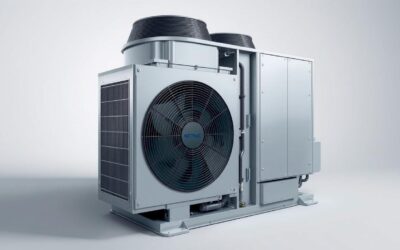

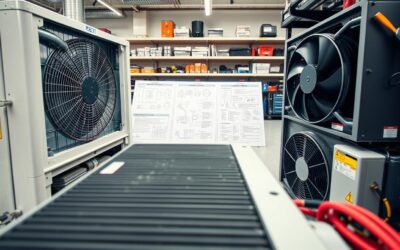
0 Comments